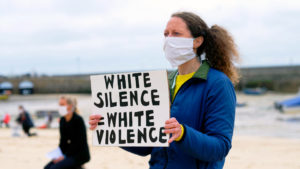“First they ignore you, then they laugh at you, then they fight you, then you win”. These wise words can be found in any number of Instagram statuses, attributed to any number of people who didn’t say them. How would we recast them for the age of late capitalism? First they ignore you, then they laugh at you, then they fight you – then they find a way to make money out of you? Put that on a £19.99 T-shirt next to a picture of Mahatma Gandhi.
In Stage Three of this process as seen during the Black Lives Matter protests, you’ll remember, right-wing media were filled with hair-raising scare stories about what BLM really wanted. “Revealed:” burbled the Daily Mail. “The British arm of Black Lives Matter’s full agenda – abolish the police, smash capitalism and close all prisons”. No reference to this loose and decentralised racial justice movement went unaccompanied by mention that three of the prominent figures in it had described themselves as “trained Marxists”. You feel on stronger ground, I suppose, resisting a movement that you’ve decided wants to tear capitalist society and its institutions to bits than one that asks us to give people of colour an equitable stake in society and the hope of walking the streets without being harassed by the cops.
Yet, capitalism being miraculously forgiving, we have now entered Stage Four. Robin DiAngelo, of White Fragility fame, makes her main living as a “diversity consultant”, and is reported to charge north of £10,000 for a speech. She lectured Coca-Cola last year on “Confronting Racism”. And a brace of new books in her tradition indicates that far from wanting to smash for-profit workplaces, the diversity-industrial complex now wants to make capitalism safe for diversity. We have reached the stage, in other words, that trained Marxists would call co-optation.
Two books — one by Y-Vonne Hutchinson, How To Talk To Your Boss About Race: Speaking Up Without Getting Shut Down, and the other, A Judgement-Free Guide To Diversity and Inclusion for Straight White Men by Felicity Hassan and Suki Sandhu — are similar in scope and approach, though Hutchinson’s primary focus is race, while Hassan and Sandhu cover racism, sexism, ageism and homo/bi/transphobia too. They’re both aiming squarely at the business how-to market, most shamelessly in the case of the latter, which again and again mentions the “business case” for diversity and inclusion and barely makes the moral case at all.
In genre terms, we’re seeing the collision of two well established discourses: the boilerplate of antiracist discourse folded into the numbing cliches of the business self-help manual. This has the unfortunate effect, at least stylistically and in publishing terms, of making the case for antiracism or workplace diversity read like another vogue in management style — the new “mindfulness”, say — rather than an urgent moral imperative.
The books adhere to the same, by now familiar, theoretical framework — with leading anti-racists DiAngelo, Kimberlé Crenshaw, and Ibram X Kendi liberally and respectfully cited, and microaggressions and privilege given the traditional working over. They both address the reader in a buttonholing, folksy way. “If you feel concerned that you may now be labeled ‘cisgender’ for the first time in your life, hold onto that thought”, say Hassan and Sandhu. “It’s all part of the learning curve”. Hutchinson opens with the words: “Let’s cut the bullshit”. If you resist any of this, in other words, it’s just another sign that you need to do “the work”.
That doesn’t mean, I should say, that the ideas they’re selling are in broad strokes wrong. We can agree that people from historically marginalised minorities continue to be disadvantaged even when they achieve de jure equality. To take one of the most obvious examples, racial disadvantage in the US is generationally baked in in all sorts of ways, and prejudice survives and adapts to legal remedies. This is why it makes sense to talk about “structural racism”.
There is much evidence — cited generously in both these books — for the notion that not only are black and brown people disproportionately under-represented in agreeable and well-paid jobs, but that more black and brown people in those jobs would make everyone, not just the black and brown people, richer and happier. And that what goes for black and brown people goes, in the broadest sense possible, for other minorities. It’s also true to say, as both these books do, that privileged people – white, cis-male, straight, able-bodied etc – can get a bit defensive when confronted with their complicity in such a system. Hassan and Sandhu address themselves, primarily, to the notional white dude standing in the way of reform; Hutchinson, primarily, to the person of colour seeking to start a Difficult Conversation with that white dude.
They both offer, in styles apt to the genre (Hassan and Sandhu: Venn diagrams, bullet-points, away-day exercises and wince-making tint-panels in which the likes of Richard Branson puff themselves by spouting abstract bromides about how much they value diversity), explanations of the jargon of the territory for bewildered newcomers, and hand-holding step-by-steps on how to help to centre marginal voices, be a good ally, and be the change in the world that you want to see. Most of the practical advice is not unobvious. Hutchinson, that said, has useful points to make about the way in which the task of changing workplace culture can all too easily fall on the unpaid labour of minority employees, and warns all too plausibly of how corporate HR departments are generally more interested in shielding the company from legal and financial risk than treating individual employees fairly.
But there’s little sense in either book that the received ideas or the received vocabulary of antiracism or gender politics needs any interrogation. This is, perhaps in keeping with the turn in identity politics where an individual’s own sense of themselves (in the case of the argument over aspects of queer and trans identity) or of their experience of oppression (in the case of much race discourse) holds an almost theological authority: that unless you have “lived experience” you don’t just have an inferior standing to consider the issues, but no standing at all.
Both books proceed from a position of epistemic confidence. “Is your workplace racist?” asks Hutchinson. “The short and simple answer is nearly certainly yes. The more nuanced answer is still nearly certainly yes”. What can the reader do? They can start, say Hassan and Sandhu, by “learning the language of diversity and inclusion”. A set of terms, rather than a set of ideas. “Set up a debate to debunk the philosophy that women compete more with each-other than their male counterparts”, they advise chirpily at one point. Foregone conclusions, regardless of the subject, isn’t what debates are traditionally about.
Yet the vocabulary is contested; and the remedies, when it comes down to fine detail, are contested too. Hassan and Sandhu make a distinction, for instance, between “diversity” and “inclusion” (though they seem to muddle the two at other points) and between “equity” and “equality”. They disagree with Hutchinson, a little, on “unconscious bias”. The Judgment-Free Guide finds the notion useful; How To Talk thinks we should stop pussyfooting around and call it racism, so as not to centre white people, their intentions and their feelings in a conversation about the harms done to people of colour. Do you capitalise “Ally”, as Hassan and Sandhu do, but leave “white” lower-case; or do you capitalise “White”, as Hutchinson does, and leave “ally” lower-case? At this point, I should say, my fragility is perhaps causing me to indulge in what Hutchinson identifies as the racist-in-denial tactic of “sealioning”: “focusing on details and small points of argumentation rather than the larger themes of the discussion”.
What I can say, which I don’t think is my fragility talking, is that however we may endorse those larger themes, or humbly submit to be educated by the emotional labour of their authors, this subject’s established orthodoxies can make for wearyingly abstract and repetitive writing. “Power is not binary”, Hutchinson writes, “It’s multifaceted and fluid”. I lost count of the number of times Hutchinson uses the word “leverage”, or Hassan and Sandhu — the front of whose book promises “everything you need to lead positive change” — talk about “journeys” and “driving change” (though, be it said, these are more the failings of bollocksy business books than identity politics books per se). As a side-note, isn’t it careless when writing about diversity and tolerance to quote, as Judgement-Free Guide does, Henry Ford and Chairman Mao — one antisemite, one mass-murderer — with approval? That’s a bit more judgement-free than many of us will be comfortable with.
Both these books default too often to a tissue of generalities and buzzphrases that tend to leave little or no impression on the mind. That isn’t sealioning. You can agree that the elimination of structural racism and all the other structural-isms is an urgent necessity, and still wish that writing on the subject were lively and original and precise; indeed, the more you recognise the urgency the more you’ll want some decent books on the subject. It’s a bit depressing to think that wine made from the vineyards of Sojourner Truth, Frederick Douglass and James Baldwin has found its way into bottles designed by Tom Peters.
Disclaimer
Some of the posts we share are controversial and we do not necessarily agree with them in the whole extend. Sometimes we agree with the content or part of it but we do not agree with the narration or language. Nevertheless we find them somehow interesting, valuable and/or informative or we share them, because we strongly believe in freedom of speech, free press and journalism. We strongly encourage you to have a critical approach to all the content, do your own research and analysis to build your own opinion.
We would be glad to have your feedback.
Source: UnHerd Read the original article here: https://unherd.com



